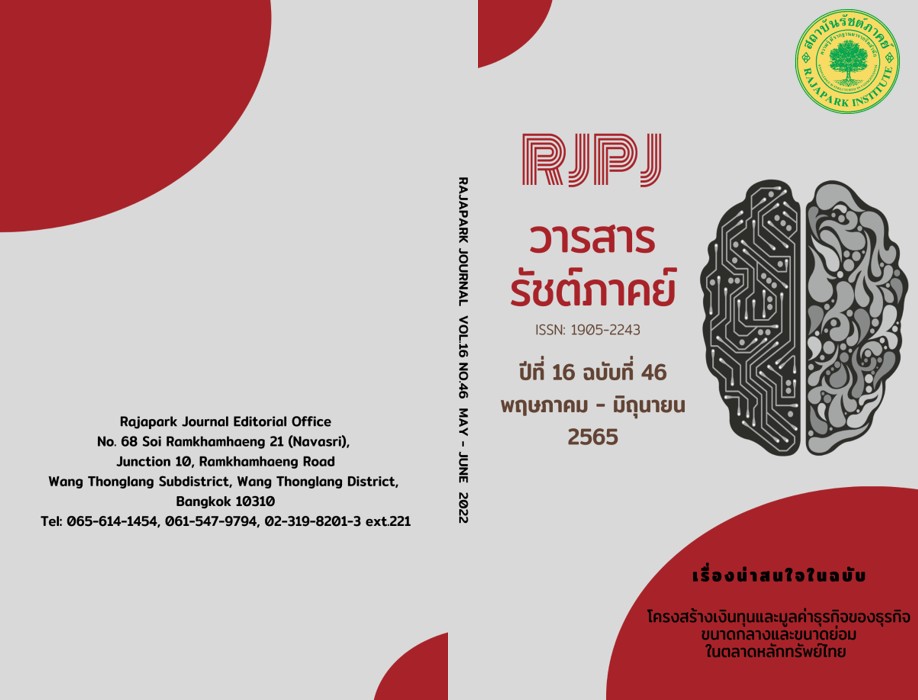A Study of Behavior of Using Food Delivery Application System: A Case study of Grab Food
Main Article Content
Abstract
This research is quantitative. The objectives are to study the characteristics of the Food Delivery (Grab Food) application system that affects the selection of food ordering services. and to study the differences in demographic data that affect the choice of the food delivery (Grab Food) application system. Food delivery (Grab Food) application system by determining the sample size, the researcher uses the formula of Cochran received a sample size of 384 samples. The statistics used in the data analysis consisted of percentage, mean, standard deviation, t-test, F-test, and one-way variance statistics (One-Way Analysis of Variance (ANOVA), The results of the research revealed that most consumers' behavior in choosing Grab Food's food delivery application system was the safest and reliable, followed by technology acceptance. The least impactful aspect was the quality of the data. and when comparing the demographic data of consumers affecting behavior in choosing the food delivery (Grab Food) application system, it was found that consumers of different sexes. The behavior in choosing the food delivery (Grab Food) application system is not different. Education levels, occupations, and different behaviors in choosing the food delivery (Grab Food) application system were significantly different at the 0.05 level.
Article Details

This work is licensed under a Creative Commons Attribution-NonCommercial-NoDerivatives 4.0 International License.
Views and opinions appearing in the Journal it is the responsibility of the author of the article, and does not constitute the view and responsibility of the editorial team.
References
Encyclopedia IT. (2018). What is Application. http://www.mindphp.com.
Foodstory. (2018). Food Delivery Grow Answer to the City People. http://www.bltbangkok.com /CoverStory/.
GRABFOOD. (2016). Why Should you Try Grab Food. https://www.grab.com/.
Hair, J. F., Hult, G. T. M., Ringle, C. M., & Sarstedt, M. (2014). A Primer on Partial Least Squares Structural Equation Modeling (PLS-SEM). Sage Publications.
Klaengkla, P. (2018). An Analysis on Optimal Attributes of Food Delivery Application in Bangkok [Independent Study, Kasetsart University].
Phongsupat, N. (2018). A Study on Food Application Market and Consumer Behavior Regarding Food Application Choice[Independent Study, Thammasat university].
Posttoday. (2015). ‘Food Delivery’ in This Era: Serving at Home. Posttoday. https://www.posttoday.com/politic/report/361916
Riengsinchai, J. (2020). Study of Food Service Order Behavior Through the Application of Consumers in Bangkok: Application Lineman, Foodpanda, Grabfood. SSRU Journal of Public Administration, 3(2), 32-48.
Taerungreaung, N. (2019). Factors That Influence the Confidence in Using Application (KMA) of Ayudhya Public Company Limited Bank’s Customers[Master’s Thesis, Silpakorn University].
Virayothin, P. (2018). Factors Affecting Consumers in Making Decisions in Using Uber Eats Application for Food Delivery[Independent Study, Bangkok University].
Wattanavijit, S. (2017). The Satisfaction of Using Grab Food Application for Food Delivery of Employees in Private Company in Bangkok Area. https://mmm.ru.ac.th/MMM/IS/vlt13-2/6014993123.pdf
Wiangta, R. (2018). Perceived Values of Product, Sales Promotion Satisfaction and the Values that Influenced the Decision to Use Food Ordering by the Grab Application (Grab Food) [Independent Study, Bangkok University].
Wutthakatdiphet, A. (2017). Digital Marketing Communication and Customers Decision Making on Online Messenger in Bangkok District[Independent Research, Bangkok University].


